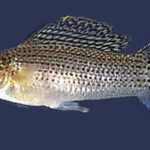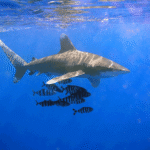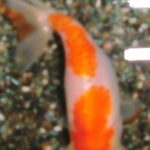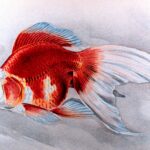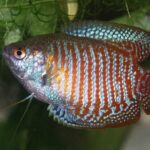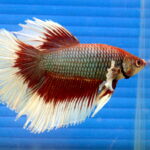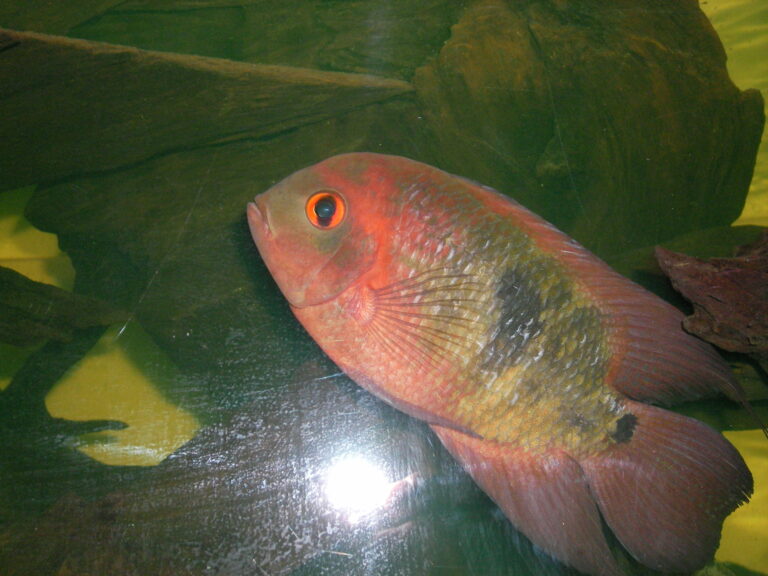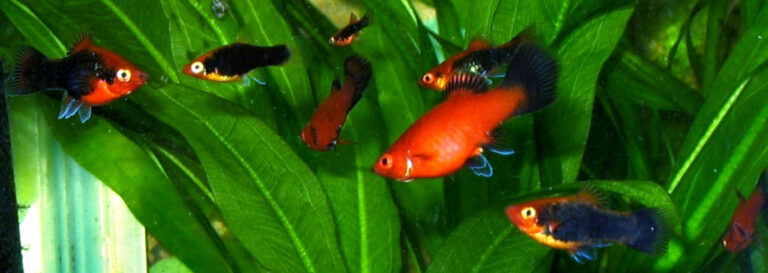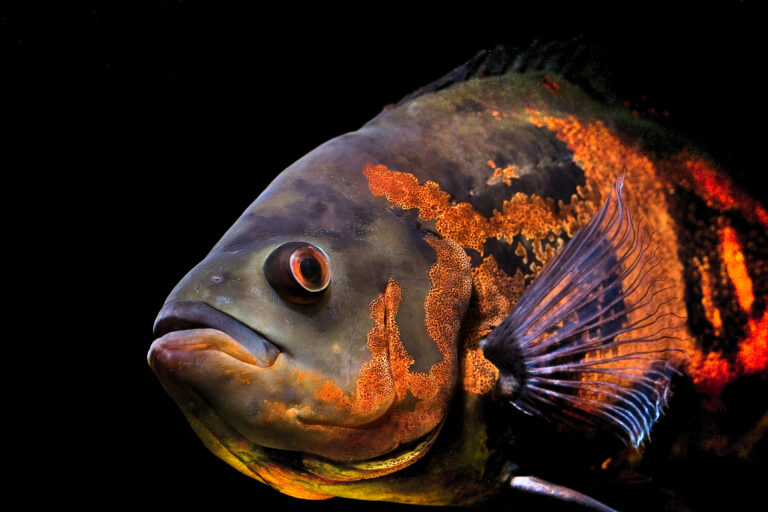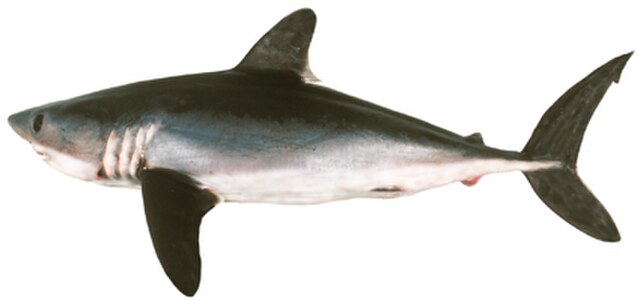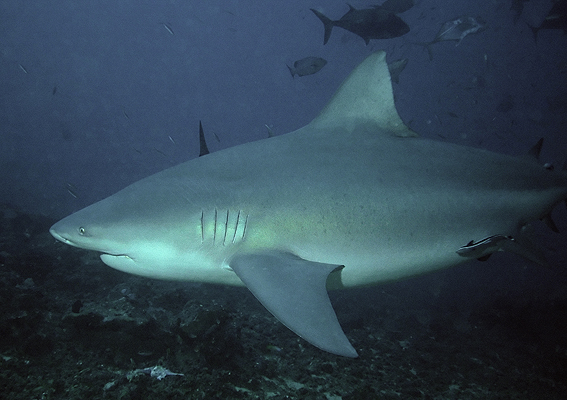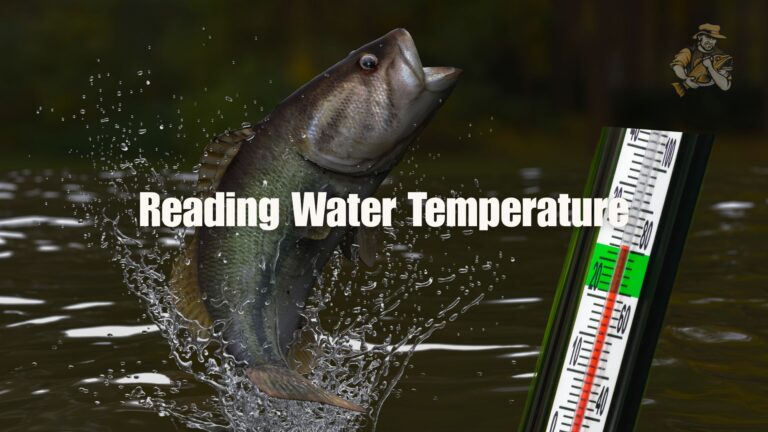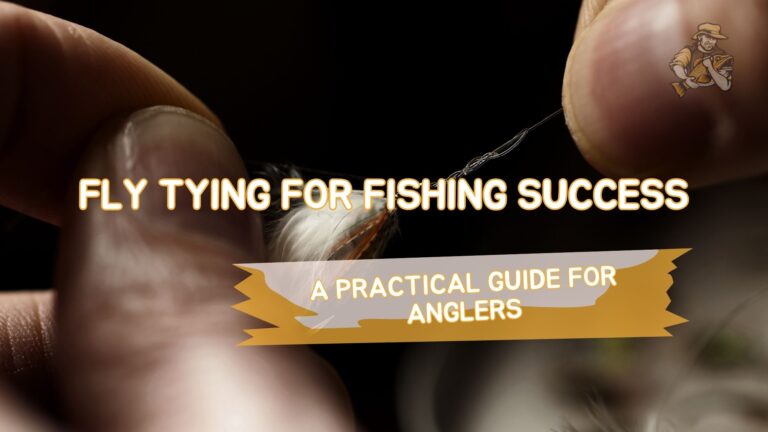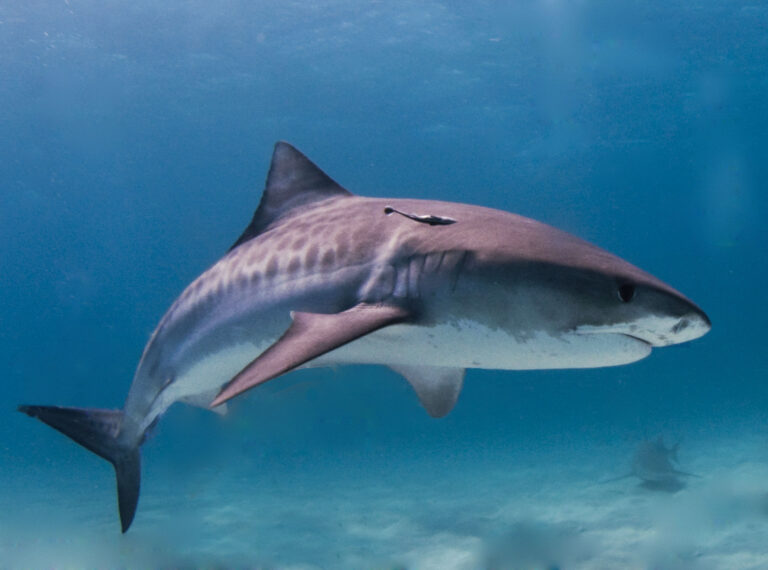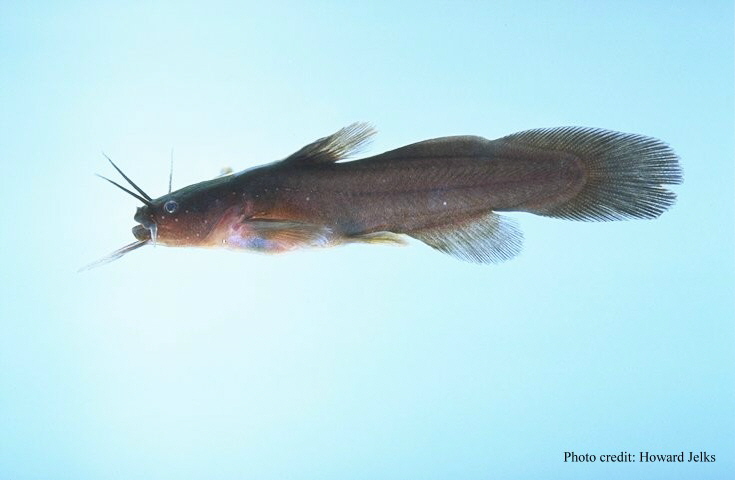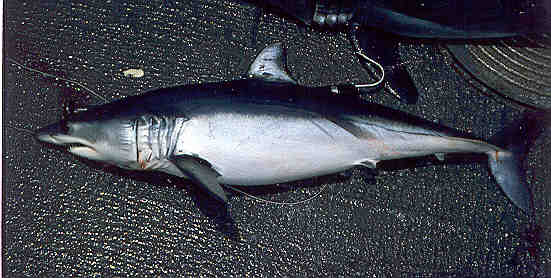Black Molly
By Ryan Maron | Last Modified: June 12, 2025
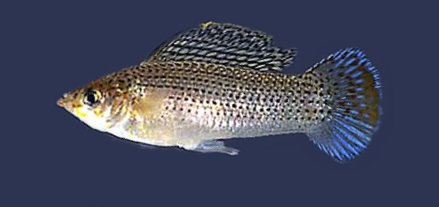
The Black Molly represents one of the most recognizable and enduring species in the freshwater aquarium trade, captivating both novice and experienced aquarists with its striking appearance and hardy nature. Scientifically known as *Poecilia sphenops*, this remarkable fish belongs to the family Poeciliidae and stands as a testament to successful selective breeding programs that have produced numerous color variations from wild-type ancestors. The Black Molly’s significance extends beyond its ornamental value, serving as an excellent model organism for studying livebearing reproduction and demonstrating remarkable adaptability to varying water conditions that has made it a cornerstone species in community aquarium ecosystems worldwide.
| Feature | Details |
|---|---|
| Common Name | Black Molly |
| Scientific Name | Poecilia sphenops |
| Family | Poeciliidae |
| Typical Size | 8-12 cm (3-5 inches), 15-30 grams |
| Habitat | Freshwater streams, rivers, and coastal areas |
| Diet | Omnivorous – algae, small invertebrates, plant matter |
| Distribution | Central America, Northern South America |
| Conservation Status | Least Concern |
Taxonomy & Classification
The Black Molly belongs to the genus *Poecilia* within the family Poeciliidae, commonly known as the livebearer family. This taxonomic classification places it alongside other popular aquarium species including guppies and platy fish, all sharing the distinctive characteristic of giving birth to live young rather than laying eggs. The species *Poecilia sphenops* was first scientifically described by Valenciennes in 1846, establishing its formal recognition within ichthyological literature.
Within the broader classification system, Black Mollies occupy the order Cyprinodontiformes, which encompasses numerous small freshwater fish species adapted to diverse aquatic environments. The family Poeciliidae consists of approximately 40 genera and over 270 species, making it one of the most diverse groups within the order. Recent molecular phylogenetic studies have confirmed the close relationship between *Poecilia sphenops* and other molly species, including the sailfin molly (*Poecilia latipinna*) and the Amazon molly (*Poecilia formosa*).
The taxonomic stability of *Poecilia sphenops* has remained relatively consistent compared to other members of its genus, though some regional populations show sufficient genetic divergence to warrant subspecies designation. These taxonomic distinctions become particularly important when considering the species’ natural distribution and the various color morphs that have emerged through both natural selection and artificial breeding programs.
Physical Description
The Black Molly exhibits a distinctive torpedo-shaped body profile that reflects its evolutionary adaptation to swift-flowing freshwater environments. Adult specimens typically reach lengths between 8 to 12 centimeters, with females generally displaying slightly larger proportions than males. The species demonstrates pronounced sexual dimorphism, with mature males developing an elongated dorsal fin and the characteristic gonopodium, a modified anal fin used for internal fertilization.
The defining characteristic of the Black Molly variant lies in its deep melanistic coloration, ranging from charcoal gray to jet black across the entire body surface. This coloration results from selective breeding programs that have concentrated melanophore cells throughout the skin, creating the uniform dark appearance that distinguishes it from wild-type specimens. The fins typically mirror the body coloration, though some individuals may exhibit subtle variations in fin pigmentation intensity.
Body structure reflects the species’ active swimming behavior, with a streamlined profile that minimizes drag in flowing water conditions. The head comprises approximately 25% of the total body length, featuring a moderately sized mouth positioned terminally for efficient surface and mid-water feeding. The caudal fin displays a rounded to slightly truncated shape, providing effective propulsion while maintaining maneuverability in confined spaces.
Scale patterns follow a standard cycloid arrangement, with approximately 28-30 scales along the lateral line. The lateral line system remains clearly visible even in heavily pigmented individuals, appearing as a subtle depression running horizontally along the body’s midsection. Eye proportions remain relatively large compared to body size, facilitating visual prey detection and predator avoidance in natural environments.
Habitat & Distribution
The natural range of *Poecilia sphenops* extends throughout Central America and northern South America, encompassing regions from Mexico southward through Guatemala, Belize, Honduras, Nicaragua, Costa Rica, and into Colombia and Venezuela. Wild populations inhabit diverse freshwater ecosystems including slow-moving rivers, coastal streams, cenotes, and brackish water environments where freshwater systems meet marine influences.
These fish demonstrate remarkable adaptability to varying water parameters, naturally occurring in environments with pH ranges from 6.5 to 8.5 and water temperatures between 22°C and 30°C. The species’ tolerance for salinity fluctuations allows populations to establish in coastal areas where tidal influences create brackish conditions, a characteristic that has contributed significantly to their success in aquarium environments.
Natural habitats typically feature abundant vegetation, submerged root systems, and moderate water flow that provides both feeding opportunities and shelter from predators. Black Mollies in wild populations often aggregate in areas with dense aquatic plant growth, utilizing the complex habitat structure for foraging and reproductive activities. Water depth preferences range from shallow margins less than one meter deep to mid-depth areas reaching approximately three meters.
The species has established introduced populations in various global locations through aquarium releases and intentional introductions, including parts of the United States, Australia, and several Caribbean islands. These non-native populations demonstrate the species’ remarkable environmental adaptability, though they may pose ecological concerns in sensitive aquatic ecosystems where they compete with native species for resources.
Geographic variation exists among natural populations, with some regional groups displaying distinct morphological characteristics and color patterns that reflect local environmental pressures and genetic isolation. These population differences have contributed to the diverse breeding stock available in the aquarium trade.
Diet & Feeding Behavior
Black Mollies exhibit omnivorous feeding behavior that reflects their opportunistic foraging strategy in natural environments. Their diet consists primarily of algae, aquatic plant matter, small invertebrates, and organic detritus found throughout their habitat range. The species demonstrates particular efficiency in algae consumption, using specialized scraping motions to remove periphyton from submerged surfaces including rocks, logs, and plant stems.
Invertebrate prey includes mosquito larvae, small crustaceans, aquatic worms, and various microorganisms that comprise the base of freshwater food webs. Feeding activity typically occurs throughout daylight hours, with peak foraging periods during early morning and late afternoon when prey availability reaches optimal levels. The species employs both surface feeding and benthic foraging strategies, adapting their feeding behavior to exploit available food sources across different water column zones.
Plant material forms a significant component of the natural diet, with Black Mollies consuming soft aquatic vegetation, algae filaments, and decaying organic matter. This herbivorous tendency provides essential nutrients and fiber necessary for proper digestive function and overall health maintenance. The species’ ability to derive nutrition from plant sources contributes to their success in environments where animal protein may be seasonally limited.
Feeding behavior demonstrates social coordination, with groups often foraging collectively in productive areas. This cooperative feeding strategy enhances individual foraging efficiency while providing increased predator detection capabilities through group vigilance. Juvenile Black Mollies initially consume smaller prey items including rotifers, copepod nauplii, and fine algae particles before transitioning to adult feeding patterns as they mature.
The species’ digestive system reflects their omnivorous nature, featuring a relatively long intestinal tract that facilitates efficient processing of both plant and animal matter. This anatomical adaptation allows Black Mollies to extract maximum nutritional value from diverse food sources encountered in their natural habitats.
Behavior & Adaptations
Black Mollies display complex social behaviors that facilitate group cohesion and reproductive success within their natural environments. The species exhibits moderate schooling tendencies, particularly during juvenile stages and in open water situations where predation pressure increases. Social hierarchies develop within established groups, with dominant individuals securing preferred feeding locations and breeding territories.
Territorial behavior becomes most pronounced during reproductive periods, when mature males establish and defend small areas against competitors. These territories typically encompass optimal spawning sites with appropriate vegetation cover and water flow characteristics. Aggressive displays include fin spreading, lateral body presentations, and chase behaviors that establish dominance relationships without causing significant physical harm.
The species demonstrates remarkable physiological adaptations to varying environmental conditions, including salinity tolerance that allows survival in brackish water environments. This euryhaline capability results from specialized gill structures and kidney function that regulate ion balance across different osmotic conditions. Temperature tolerance ranges support survival in tropical and subtropical climates with seasonal variation.
Swimming behavior reflects their streamlined body design, with efficient propulsion generated through coordinated fin movements and body undulation. Black Mollies maintain active swimming patterns throughout daylight hours, utilizing both horizontal and vertical water column movements to exploit feeding opportunities and avoid predation threats.
Stress response mechanisms include rapid color changes in some individuals, schooling behavior intensification, and seeking shelter within available cover structures. These adaptive responses enhance survival probability during predator encounters or environmental disturbances. The species also demonstrates remarkable resilience to water quality fluctuations, tolerating temporary adverse conditions through behavioral and physiological adjustments.
Learning capabilities include recognition of feeding schedules, territorial boundaries, and predator identification, suggesting cognitive abilities that support adaptive behavior modification based on environmental experience.
Reproduction & Life Cycle
Black Mollies reproduce through internal fertilization and live birth, a reproductive strategy that provides significant advantages in freshwater environments. Sexual maturity typically occurs between 3 to 6 months of age, depending on environmental conditions, nutrition, and genetic factors. Males develop distinctive reproductive anatomical features including the gonopodium, a modified anal fin that facilitates sperm transfer during mating.
The reproductive cycle begins with elaborate courtship behaviors where males display vibrant coloration and perform ritualized swimming patterns to attract females. Successful mating results in internal fertilization, with females capable of storing sperm for multiple reproductive cycles. This sperm storage capability allows females to produce several broods from a single mating event, maximizing reproductive efficiency.
Gestation periods range from 28 to 35 days, influenced by water temperature and environmental conditions. Females exhibit increased abdominal distension during pregnancy and may display behavioral changes including reduced activity and increased shelter-seeking behavior. Brood sizes typically range from 20 to 60 fry, with larger females generally producing more offspring per reproductive cycle.
Parturition occurs through live birth, with females releasing fully developed fry capable of immediate independent survival. Unlike some fish species, Black Mollies do not provide parental care following birth, and adults may consume their own offspring if adequate shelter is unavailable. This reproductive strategy emphasizes quantity over individual offspring investment.
Fry development progresses rapidly under optimal conditions, with juveniles reaching reproductive maturity within 3 to 6 months. Growth rates depend significantly on food availability, water temperature, and population density. The species can produce multiple broods annually, contributing to their success in both natural and aquarium environments.
Reproductive behavior similar to that observed in Black Mollies occurs across various molly fish varieties, demonstrating the consistent livebearing strategies that characterize the Poeciliidae family.
Predators & Threats
Natural predators of Black Mollies include larger fish species, aquatic birds, and various invertebrate predators that inhabit overlapping ecosystems. Piscivorous fish such as bass, pike, and larger cichlid species pose significant predation pressure on both juvenile and adult Black Mollies. The species’ moderate size makes them vulnerable to predators throughout most of their life cycle, necessitating behavioral adaptations for survival.
Avian predators including herons, egrets, and kingfishers target Black Mollies during shallow water foraging activities. These aerial predators exploit the species’ surface feeding behavior and congregation patterns in productive feeding areas. Aquatic invertebrates such as large dragonfly nymphs, water beetles, and predatory aquatic insects primarily threaten juvenile Black Mollies during their vulnerable early life stages.
Environmental threats encompass habitat degradation, water pollution, and climate change impacts on freshwater ecosystems. Agricultural runoff containing pesticides and fertilizers can significantly impact Black Molly populations through direct toxicity and indirect effects on food web dynamics. Urban development often results in habitat fragmentation and altered hydrology that disrupts natural population distributions.
Introduced predatory species in non-native environments pose emerging threats to established Black Molly populations. These invasive predators may lack co-evolutionary history with Black Mollies, potentially creating novel predation pressures that exceed the species’ adaptive capabilities. Competition from other introduced fish species can also impact resource availability and habitat quality.
Human activities including overharvesting for the aquarium trade, habitat modification, and water diversion projects continue to pressure wild populations in some regions. While the species maintains stable populations overall, localized declines have been documented in areas experiencing intensive human development or environmental degradation.
Disease outbreaks, particularly those involving introduced pathogens, represent additional threats to wild Black Molly populations. Intensive aquaculture operations and aquarium releases can introduce novel diseases to wild populations lacking natural immunity.
Conservation Status
The International Union for Conservation of Nature (IUCN) currently classifies *Poecilia sphenops* as Least Concern, reflecting the species’ widespread distribution, stable populations, and adaptive resilience to environmental variations. This conservation status indicates that Black Mollies face no immediate extinction risk and maintain viable populations throughout their natural range.
Population assessments across the species’ geographic distribution reveal generally stable trends, with some regional variations due to local environmental conditions and human activities. The species’ broad habitat tolerance and reproductive efficiency contribute to population resilience against moderate environmental disturbances and anthropogenic impacts.
Conservation efforts focus primarily on habitat preservation and water quality maintenance within the species’ natural range. Freshwater ecosystem protection benefits Black Mollies along with numerous other aquatic species sharing similar habitat requirements. International cooperation on watershed management and pollution control provides broader conservation benefits for Central American freshwater biodiversity.
The species’ success in aquarium environments has created a sustainable captive population that reduces pressure on wild stocks for the ornamental fish trade. Captive breeding programs have largely eliminated the need for wild collection, though some specialty variants may still involve wild-caught specimens for breeding stock diversity.
Climate change presents potential long-term challenges for Black Molly populations, particularly in regions experiencing altered precipitation patterns and temperature extremes. However, the species’ physiological adaptability and broad environmental tolerance suggest reasonable resilience to moderate climate-related changes.
Research priorities include continued monitoring of wild populations, assessment of introduced population impacts on native ecosystems, and evaluation of emerging environmental threats. Conservation strategies emphasize ecosystem-level protection rather than species-specific interventions, recognizing that healthy freshwater habitats support diverse aquatic communities including Black Mollies.
Human Interaction
Black Mollies represent one of the most significant success stories in freshwater aquaculture, with global aquarium trade values reaching millions of dollars annually. Commercial breeding operations span multiple continents, producing millions of specimens yearly for both domestic and international markets. The species’ hardy nature and attractive appearance have established it as a cornerstone species in the ornamental fish industry.
Aquarium keeping has driven extensive selective breeding programs that have produced numerous color variants, fin types, and body shapes beyond the classic black coloration. These breeding efforts have created distinctive strains including balloon mollies, lyretail mollies, and various color combinations that expand the species’ commercial appeal. Professional breeders continue developing new varieties to meet evolving market demands.
Educational applications include use in school biology programs, university research facilities, and public aquarium displays that demonstrate livebearing reproduction and freshwater ecosystem dynamics. The species’ predictable breeding behavior and relatively simple care requirements make it valuable for educational purposes across various academic levels.
Scientific research applications encompass studies on reproductive biology, environmental adaptation, and genetic diversity within the Poeciliidae family. Black Mollies serve as model organisms for investigating livebearing reproductive strategies and environmental stress responses. Their tolerance for laboratory conditions facilitates controlled experimental studies on fish behavior and physiology.
Cultural significance varies across regions, with some areas incorporating Black Mollies into traditional practices or local aquarium keeping traditions. The species’ association with good fortune and prosperity in certain cultures has influenced its popularity in residential and commercial aquarium installations.
Interactions with guppies and other livebearing species in community aquarium settings demonstrate compatible social behaviors and similar care requirements that facilitate mixed-species installations.
Economic impacts extend beyond direct sales to include supporting industries such as aquarium equipment manufacturing, specialized foods, and veterinary services. The species’ contribution to the broader aquarium industry ecosystem supports thousands of jobs worldwide across various sectors.
Interesting Facts
Black Mollies possess the remarkable ability to survive in both freshwater and brackish water environments, with some populations naturally occurring in coastal areas where salinity levels fluctuate with tidal cycles. This euryhaline tolerance allows them to colonize diverse aquatic habitats that would be uninhabitable for most freshwater fish species.
The species can store sperm for extended periods, enabling females to produce multiple broods from a single mating event. This reproductive adaptation can result in continued offspring production for up to six months following successful copulation, maximizing reproductive efficiency in unpredictable environments.
Wild-type Black Mollies often display different coloration patterns compared to their aquarium counterparts, typically featuring silver-gray bodies with black spotting or mottled patterns. The uniform black coloration popular in aquarium specimens results from intensive selective breeding programs that concentrated melanin pigmentation.
Temperature preferences can influence the sex ratio of offspring in some molly populations, a phenomenon known as temperature-dependent sex determination. Higher temperatures during development may skew offspring production toward one sex, though this mechanism varies among different populations and environmental conditions.
Black Mollies demonstrate sophisticated social recognition abilities, capable of distinguishing between familiar and unfamiliar individuals within their groups. This recognition facilitates stable social hierarchies and reduces aggressive interactions among established community members.
The species exhibits behavioral flexibility in feeding strategies, capable of switching between herbivorous and carnivorous feeding modes depending on seasonal resource availability. This dietary adaptability contributes to their success across diverse environmental conditions and food web dynamics.
Some Black Molly populations have been documented performing coordinated group feeding behaviors, where individuals work together to disturb substrate materials and expose hidden invertebrate prey. This cooperative foraging strategy enhances feeding efficiency for all group participants.
The species’ swimming patterns change dramatically in response to predator presence, with groups transitioning from loose aggregations to tight schooling formations within seconds of detecting potential threats. This rapid behavioral response demonstrates sophisticated predator detection and avoidance capabilities.
Frequently Asked Questions
How long do Black Mollies typically live in aquarium environments?
Black Mollies generally live between 3 to 5 years in well-maintained aquarium conditions, though some exceptional individuals may reach 6 years with optimal care. Lifespan depends significantly on water quality, nutrition, genetic factors, and environmental stress levels.
Can Black Mollies survive in saltwater aquariums?
While Black Mollies possess some salinity tolerance, they are not true marine fish and cannot survive in full-strength seawater. They can adapt to low-salinity brackish water conditions with specific gravity up to 1.010, but require gradual acclimatization to prevent osmotic stress.
What water temperature range is optimal for Black Molly health?
Black Mollies thrive in water temperatures between 24°C to 28°C (75°F to 82°F), with 26°C (79°F) representing the optimal temperature for growth, reproduction, and overall health. Temperatures below 20°C or above 32°C can cause significant stress and health complications.
How can aquarists distinguish between male and female Black Mollies?
Male Black Mollies develop a gonopodium (modified anal fin) used for reproduction, while females retain the standard fan-shaped anal fin. Additionally, males typically display more elongated dorsal fins and smaller overall body size compared to females, who develop fuller, rounder abdomens when mature.
Conclusion
The Black Molly stands as a testament to successful adaptation and selective breeding within freshwater aquaculture, representing both ecological resilience and commercial significance in the global ornamental fish trade. Their role as hardy, prolific livebearers continues to make them invaluable for aquarium enthusiasts while their stable wild populations ensure continued genetic diversity for future generations. As climate change and habitat modification present new challenges to freshwater ecosystems, the Black Molly’s remarkable environmental adaptability positions them as a species likely to persist and thrive in changing aquatic landscapes worldwide.
Share The Article:
More Fish Species:
-
Chocolate Cichlid
The Chocolate Cichlid stands as one of South America’s most distinctive freshwater species, captivating aquarists and researchers alike with…
-
Basking Shark
The Basking Shark stands as one of the ocean’s most magnificent gentle giants, representing the second-largest fish species on…
-
Tuxedo Platy
The Tuxedo Platy (Xiphophorus maculatus) stands as one of the most recognizable and beloved freshwater aquarium fish species, distinguished…
-
Oscar Fish
The Oscar Fish (*Astronotus ocellatus*) stands as one of South America’s most recognizable freshwater cichlids, earning widespread recognition both…
-
Porbeagle Shark
The Porbeagle Shark (*Lamna nasus*) stands as one of the most fascinating and ecologically significant predators in the North…
-
Bull Shark
The Bull Shark represents one of the most formidable apex predators in marine ecosystems worldwide. Known scientifically as Carcharhinus…
Discover
-
Reading Water Temperature: Seasonal Cues for Better Fishing
I’ve spent more mornings than I can count staring at a thermometer clipped to my fishing line, watching those…
-
Pacific Northwest Salmon Fishing: Guide to Puget Sound and Columbia River
There’s something almost magical about the way Pacific Northwest salmon fight on the end of your line. I still…
-
Kayaking Fishing: Ultimate Guide for Water Adventurers
There’s something magical about gliding across the water in a kayak with a fishing rod in hand. The stealthy…
-
Fly Tying for Fishing Success: A Practical Guide for Anglers
There’s something deeply satisfying about catching a fish on a fly you’ve tied with your own hands. I still…
-
Best Fishing Spots in Florida: Top Locations for 2025
Florida’s nickname as the “Fishing Capital of the World” isn’t just clever marketing. With over 7,700 lakes, 10,550 miles…
-
7 Shark Fishing Tactics That Actually Work (Expert Guide)
Shark fishing remains one of those bucket-list experiences that separates casual anglers from the truly adventure-hungry. But here’s the…
Discover
-
Balloon Molly
The Balloon Molly (*Poecilia latipinna* var.) represents one of the most distinctive and popular ornamental fish varieties in the…
-
Great Lakes Fishing Tactics That Nobody Talks About (But Should)
Ever notice how some anglers consistently haul in impressive catches from the Great Lakes while others struggle to get…
-
Tiger Shark
The Tiger Shark (Galeocerdo cuvier) represents one of the ocean’s most formidable apex predators, earning its distinctive name from…
-
Tadpole Madtom
The Tadpole Madtom (Noturus gyrinus) represents one of North America’s smallest and most elusive catfish species, playing a crucial…
-
Mickey Mouse Platy
The Mickey Mouse Platy (*Xiphophorus maculatus*) stands as one of the most recognizable and beloved freshwater aquarium fish in…
-
Shortfin Mako Shark
The Shortfin Mako Shark stands as one of the ocean’s most remarkable predators, combining exceptional speed with sophisticated hunting…

